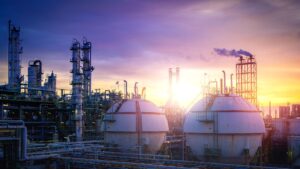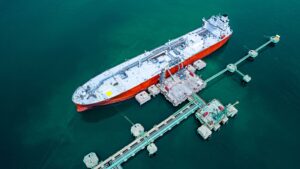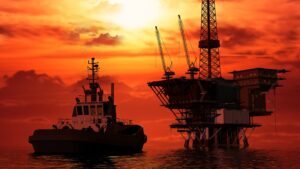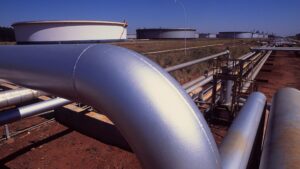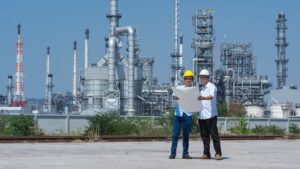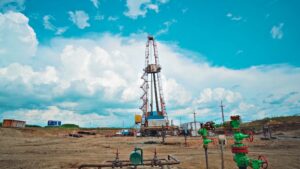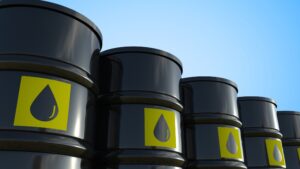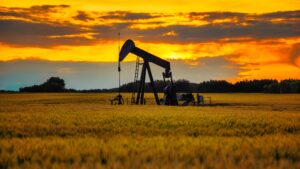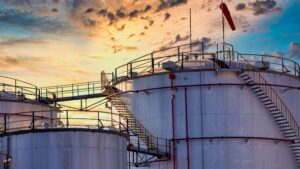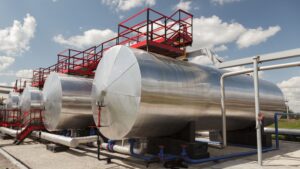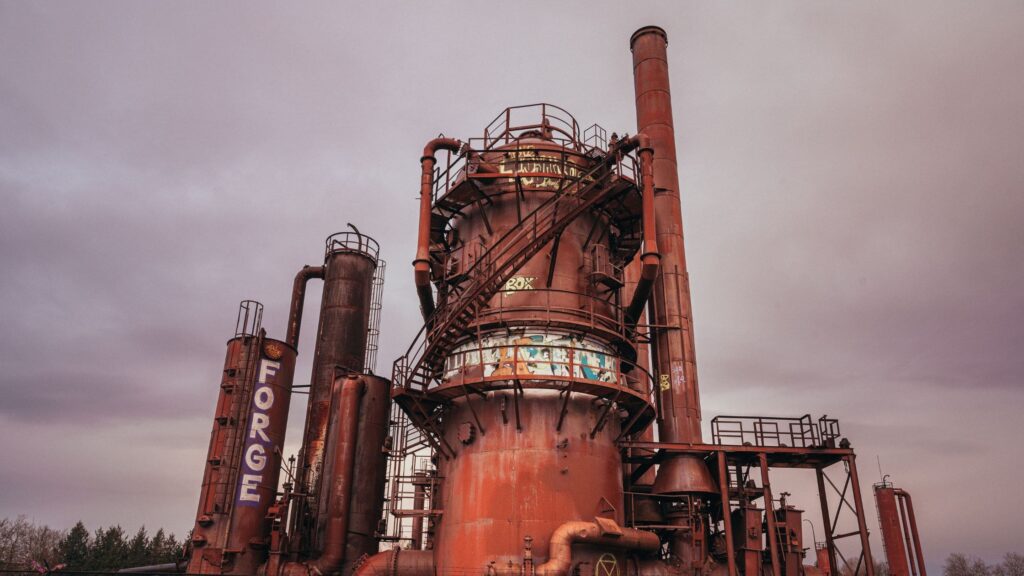This article focuses on the wide range of activities that happens in the petroleum industry and what makes it stand out as a vital component of the energy sector.
What is Petroleum?
Petroleum is a naturally occurring liquid found in geological formations beneath the Earth’s surface. It is composed of a complex mixture of hydrocarbons, primarily consisting of crude oil and natural gas. These hydrocarbons are extracted and processed to produce various petroleum products, including gasoline, diesel, and jet fuel.
How is Petroleum Formed and What Are Its Key Components?
Petroleum is formed through natural processes over millions of years. It originates from the remains of ancient marine organisms, primarily plankton and algae. These remains are buried under layers of sediment and subjected to intense heat and pressure, transforming them into hydrocarbons. The key components of petroleum include crude oil and natural gas, which are extracted and refined to produce various petroleum products.
Formation of Petroleum
Petroleum formation involves several stages of geological transformation. The process begins with the accumulation of organic material in sedimentary rock layers and ends with the creation of crude oil and natural gas reservoirs.
- Accumulation of Organic Material: Organic matter, mainly from plankton and algae, accumulates on the ocean floor.
- Burial Under Sediments: Layers of sediment cover the organic material, protecting it from decomposition.
- Heat and Pressure: Over millions of years, the sediment layers apply heat and pressure, initiating chemical reactions that transform the organic matter.
- Formation of Hydrocarbons: The organic material is converted into hydrocarbons, forming crude oil and natural gas.
- Migration and Trapping: The hydrocarbons migrate through porous rock formations and become trapped in reservoirs, ready for extraction.
Components of Petroleum
Petroleum is composed of various chemical and physical compounds, primarily hydrocarbons. These compounds determine the properties and uses of petroleum products.
- Alkanes: Saturated hydrocarbons that are major components of crude oil.
- Cycloalkanes: Ring-shaped hydrocarbons found in crude oil.
- Aromatic Hydrocarbons: Compounds with a ring structure that influence the octane rating of gasoline.
- Sulfur Compounds: Impurities that are removed during refining to reduce emissions.
- Nitrogen Compounds: Minor components that can affect refining processes.
- Oxygen Compounds: Include acids and phenols, which need removal during refining to prevent corrosion.
Is Petroleum Renewable?
Petroleum is not renewable. It forms over millions of years from the remains of ancient organisms buried under sediment. Once these resources are depleted, they cannot be replenished on a human timescale.
For better context, here is the classification of petroleum;
- Asphalt: A heavy, semi-solid form of petroleum used primarily for road construction.
- Bitumen: A dense, viscous form of petroleum used in road surfacing and roofing.
- Crude Oil: A liquid form of petroleum that is refined into various fuels and products.
- Natural Gas: A gaseous form of petroleum used for heating, electricity generation, and as a raw material in chemical processes.
What is the History of the Petroleum Industry?
The petroleum industry has a rich history dating back to ancient civilizations. Over centuries, it has evolved from rudimentary oil collection methods to a highly sophisticated and technologically advanced industry that plays a critical role in the global economy. The industry’s growth is marked by significant milestones in exploration, extraction, refining, and transportation.
Early Beginnings
Petroleum, a naturally occurring liquid found in rock formations, consists of a complex mixture of hydrocarbons of various molecular weights and other organic compounds. It is generally accepted that oil is formed mostly from the carbon-rich remains of ancient plankton after exposure to heat and pressure in Earth’s crust over hundreds of millions of years. Over time, the decayed residue was covered by layers of mud and silt, sinking further into Earth’s crust and preserved there between hot and pressured layers, gradually transforming into oil reservoirs.
In the early stages, oil was collected from surface seeps and used primarily for medicinal purposes and as an adhesive. The first recorded oil well was drilled in 1859 by Edwin Drake in Titusville, Pennsylvania, marking the beginning of the modern petroleum industry.
Developments in the 19th and 20th Century
The 19th and 20th centuries were pivotal periods for the petroleum industry, characterized by major discoveries, technological innovations, and the establishment of important infrastructures.
- Early Oil Production in Russia: In 1825, Imperial Russia produced 3,500 tons of oil, doubling its output by the mid-century. This early production laid the groundwork for Russia’s significant role in the global oil market.
- First Oil Drilling in Azerbaijan: Oil drilling began in Baku, Azerbaijan, in 1846. By 1906, the Russian Empire completed the 833 km Baku-Batum pipeline and a 162 km pipeline from Chechnya to the Caspian, facilitating the transportation of oil to broader markets.
- Baku Oil Wells and Refineries: The first drilled oil wells in Baku were established by Ivan Mirzoev between 1871 and 1872. By 1884, nearly 200 small refineries operated in Baku’s suburbs, making the region a significant hub for oil refining.
- Global Oil Market Dominance: At the turn of the 20th century, Imperial Russia’s oil output, mainly from the Apsheron Peninsula, accounted for half of the world’s production. This dominance highlighted the strategic importance of the region in global energy supplies.
- Early Oil Transportation Innovations: In 1878, Ludvig Nobel’s Branobel company launched the first oil tanker on the Caspian Sea, revolutionizing oil transportation and setting the stage for modern shipping methods.
- Oil Refining Developments in America and Europe: Samuel Kier established America’s first oil refinery in Pittsburgh in 1853. Meanwhile, Ignacy Łukasiewicz built one of the first modern oil refineries in present-day Poland between 1854 and 1856, advancing refining techniques and increasing the availability of refined petroleum products.
- Canada’s First Commercial Oil Well: The first commercial oil well in Canada became operational in 1858 at Oil Springs, Ontario. James Miller Williams extracted 1.5 million liters of crude oil by 1860, marking Canada’s entry into the petroleum industry.
- US Oil Drilling Boom: Modern oil drilling in the United States began in the 1850s, with Edwin Drake’s 1859 well near Titusville, Pennsylvania, triggering a major oil boom. This development spurred further exploration and production across the country.
- Development of Offshore Drilling: In the early 1930s, the Texas Company developed mobile steel barges for drilling in the Gulf of Mexico. In 1947, Kerr-McGee Oil Industries completed the first oil discovery drilled out of sight of land in the Gulf of Mexico, pioneering offshore drilling technologies.
- World War II and Post-War Oil Industry: Control of oil supply played a crucial role during World War II. Post-war, the Middle East emerged as a leading oil producer. Significant developments included deep-water drilling, the introduction of the drillship, and the growth of a global shipping network for petroleum. In 1949, the first offshore oil drilling at Oil Rocks in the Caspian Sea led to the construction of a city on pylons.
Modern Advances in the 21st Century
The 21st century has brought about significant advancements and changes in the petroleum industry, driven by technological innovation and a growing emphasis on sustainability.
- Hydraulic Fracturing (Fracking): Hydraulic fracturing, or fracking, has revolutionized oil and gas production, particularly in North America. This technique involves injecting high-pressure fluid into shale rock formations to release natural gas and oil. Fracking has significantly increased the availability of fossil fuels and reshaped the energy landscape.
- Deepwater Drilling: Advances in deepwater drilling technology have enabled the extraction of oil and gas from ocean depths previously thought to be inaccessible. This has opened new frontiers for exploration and production, particularly in regions like the Gulf of Mexico and offshore Brazil.
- Digital Transformation: The adoption of digital technologies, including data analytics, automation, and artificial intelligence, has improved operational efficiency and reduced costs. These technologies help optimize production processes, predict equipment failures, and enhance decision-making.
- Environmental Regulations: Increasing awareness of environmental impacts has led to stricter regulations aimed at reducing greenhouse gas emissions and minimizing ecological damage. The petroleum industry is investing in cleaner technologies and exploring carbon capture and storage (CCS) methods to mitigate its environmental footprint.
- Renewable Energy Integration: As the global energy market shifts towards sustainability, the petroleum industry is exploring ways to integrate renewable energy sources. This includes investing in wind, solar, and biofuels to diversify energy portfolios and reduce reliance on fossil fuels.
- Global Market Dynamics: The dynamics of the global petroleum market continue to evolve, influenced by geopolitical factors, economic trends, and technological advancements. Major oil-producing countries, including those in the Middle East, Russia, and the United States, play critical roles in shaping market trends and prices.
What are the Major Structural Components of the Petroleum Industry?
The petroleum industry is a vast and complex system that involves numerous stages from exploration to the distribution of petroleum products. Understanding its major structural components helps to appreciate the intricate processes involved in delivering energy resources to consumers. The industry is broadly divided into three main segments: upstream, midstream, and downstream.
Upstream
Upstream refers to the exploration and production segment of the oil and gas industry. This is the initial phase where oil and natural gas are located, drilled, and extracted from beneath the Earth’s surface. It involves a range of activities and technologies designed to find and produce petroleum efficiently.
Key Activities and Technologies in Upstream:
- Exploration: The search for oil and gas reserves using geological surveys, seismic testing, and exploratory drilling.
- Drilling: The process of creating wells to access oil and natural gas deposits. This includes both onshore and offshore drilling.
- Completion: Preparing wells for production, which involves casing, cementing, and perforating the wellbore.
- Production: Extracting oil and gas from the wells and bringing them to the surface.
- Well Logging: Recording and analyzing geological formations encountered during drilling to optimize extraction.
- Hydraulic Fracturing (Fracking): A technique to enhance oil and gas recovery by injecting high-pressure fluid into rock formations to create fractures.
Midstream
Midstream refers to the transportation, storage, and marketing of oil and natural gas after they have been produced. This segment ensures that the extracted resources are moved from production sites to refineries and eventually to distribution centers.
Key Activities and Technologies in Midstream:
- Transportation: Moving oil and gas via pipelines, tankers, and railroads from production sites to refineries and distribution points.
- Storage: Holding oil and gas in tanks, caverns, or other storage facilities until they are needed for refining or sale.
- Gathering: Collecting oil and gas from multiple wells and transporting them to processing facilities.
- Processing: Removing impurities from natural gas and separating its components (e.g., natural gas liquids).
- Compression: Increasing the pressure of natural gas to facilitate its transportation through pipelines.
- LNG Production: Converting natural gas to liquid form (liquefied natural gas) for easier transport, especially over long distances.
Downstream
Downstream oil and gas activities involve refining, distributing, and selling petroleum products. This segment is crucial for transforming crude oil into usable products like gasoline, diesel, and jet fuel, which are essential for various industries and consumers.
Key Activities in Downstream:
- Refining: Processing crude oil into various petroleum products.
- Distribution: Transporting refined products to different markets.
- Retailing: Selling petroleum products directly to consumers through gas stations and other outlets.
- Petrochemical Production: Converting hydrocarbons into chemicals used for making plastics, fertilizers, and other products.
- Quality Control: Ensuring products meet regulatory and safety standards.
- Marketing: Promoting and selling petroleum products to end-users.
How are Mineral Rights Important for the Petroleum Industry?
Mineral rights are a critical aspect of the petroleum industry as they determine the ownership and entitlement to extract and profit from underground resources like oil and natural gas. These rights are essential for companies involved in exploration and production.
- Ownership and Access: Companies need mineral rights to access and extract natural gas and crude oil.
- Legal Framework: Establishing clear ownership helps prevent disputes and legal challenges.
- Revenue Generation: Mineral rights allow landowners to earn royalties from oil and natural gas production.
- Investment Security: Clear rights ensure that companies can invest in exploration and production with reduced risk.
- Economic Impact: Revenues from mineral rights contribute to local and national economies.
- Environmental Regulation: Rights include responsibilities for adhering to environmental standards and minimizing greenhouse gas emissions.
What Are the Methods of Petroleum Exploration?
The main methods of petroleum exploration are seismic surveys, drilling, and satellite imagery. These techniques are crucial for locating oil and natural gas deposits and assessing their potential for production.
- Seismic Surveys: Use sound waves to map underground rock formations.
- Drilling: Involves creating wells to extract oil and gas.
- Satellite Imagery: Helps identify surface anomalies that might indicate the presence of hydrocarbons.
- Magnetic Surveys: Measure variations in the Earth’s magnetic field to detect oil-bearing structures.
- Gravitational Surveys: Identify density differences in subsurface rocks.
- Geochemical Analysis: Examines soil, water, and gas samples for traces of hydrocarbons.
What are Unconventional Oil Reservoirs?
Unconventional oil reservoirs include shale oil, tar sands, and other sources that require advanced extraction techniques. These reservoirs are vital for meeting global energy demands as conventional reserves decline.
- Shale Oil: Extracted from shale rock formations using hydraulic fracturing.
- Tar Sands: Consist of a mixture of sand, clay, water, and bitumen, extracted through mining or in-situ methods.
- Tight Oil: Found in low-permeability rocks, requiring hydraulic fracturing for extraction.
- Coalbed Methane: Natural gas extracted from coal seams.
- Oil Shale: Organic-rich rocks that produce oil when heated.
How is Petroleum Extracted?
Petroleum extraction typically involves several methods, including onshore and offshore drilling. These techniques are essential for accessing crude oil and natural gas from beneath the Earth’s surface.
Onshore Drilling
Onshore drilling refers to the process of extracting petroleum from land-based oil wells. This method involves several techniques to locate and extract oil and natural gas deposits found in sedimentary rock formations.
- Rotary Drilling: A rotating drill bit penetrates the earth to reach oil reservoirs.
- Directional Drilling: Allows drilling at multiple angles to access a larger area from a single site.
- Hydraulic Fracturing: High-pressure fluid is used to fracture rock formations, releasing trapped oil and gas.
- Cable Tool Drilling: A traditional method where a heavy bit repeatedly impacts the ground to break up rock.
- Air Drilling: Uses compressed air instead of drilling fluid to lift cuttings from the borehole.
- Slim Hole Drilling: Involves drilling narrower wells, reducing environmental impact and cost.
Offshore Drilling
Offshore drilling involves extracting petroleum from beneath the ocean floor. This method is used to tap into underwater oil reserves, often located in sedimentary rock formations.
- Fixed Platform Drilling: Platforms anchored to the ocean floor are used for drilling in shallow waters.
- Floating Platform Drilling: Semi-submersible rigs and drillships are used in deeper waters, capable of drilling in various water depths.
- Subsea Drilling: Equipment installed on the seabed is controlled remotely from surface vessels or platforms.
- Extended Reach Drilling: Allows drilling horizontally to access deposits far from the drilling site.
- Tension Leg Platform: A buoyant platform tethered to the seabed by tensioned cables, used in deep waters.
- Dynamic Positioning: Systems on drillships or semi-submersibles that use thrusters to maintain position without anchors.
How is Petroleum Refined?
The refining process of petroleum involves several steps that transform crude oil into useful products such as gasoline, diesel, and jet fuel.
- Distillation: Crude oil is heated in a furnace and then fed into a distillation column where it is separated into different fractions based on boiling points.
- Conversion: Heavy fractions from distillation are converted into lighter products through processes like cracking, reforming, and coking.
- Cracking: Breaks down large hydrocarbon molecules into smaller ones.
- Reforming: Alters molecular structures to produce higher-octane gasoline.
- Coking: Converts heavy residues into lighter products and solid coke.
- Treating: Removes impurities such as sulfur, nitrogen, and metals to meet environmental and quality standards.
- Hydrotreating: Uses hydrogen to remove sulfur.
- Desulfurization: Specifically targets sulfur compounds for removal.
- Blending: Different refined products are mixed to create specific grades of gasoline, diesel, and other fuels.
- Storage and Distribution: Refined products are stored in large tanks before being transported to distribution points like gas stations.
Transportation and Storage of Petroleum
Transporting and storing petroleum involve multiple methods to ensure safe and efficient delivery from production sites to end users.
Pipelines:
- Crude Oil Pipelines: Transport crude oil from production sites to refineries.
- Product Pipelines: Carry refined products to distribution terminals.
- Safety Measures: Leak detection systems, regular maintenance, and corrosion prevention.
Shipping:
- Oil Tankers: Large ships that transport crude oil and refined products across oceans.
- LNG Carriers: Specialized tankers for transporting liquefied natural gas.
- Safety Measures: Double-hull designs, spill response plans, and international regulations.
Rail Transport:
- Tank Cars: Used for transporting oil overland where pipelines are not available.
- Safety Measures: Enhanced tank car standards, routing safety assessments.
Trucks:
- Tanker Trucks: Deliver petroleum products to local distribution points.
- Safety Measures: Driver training, spill containment kits, and regular inspections.
Storage:
- Tank Farms: Large facilities with multiple storage tanks for crude oil and refined products.
- Underground Storage: Used for storing natural gas and strategic petroleum reserves.
- Safety Measures: Fire suppression systems, environmental monitoring, and secure fencing.
How Are Petroleum and Its Byproducts Utilized in Various Industries?
Petroleum and its byproducts play crucial roles in many industries, providing essential materials and energy sources.
- Energy: Petroleum is a primary energy source, used to generate electricity and power vehicles.
- Plastics: Crude oil is refined to produce petrochemicals, the building blocks of plastics.
- Pharmaceuticals: Petroleum byproducts are used to manufacture a wide range of medicines.
- Agriculture: Fertilizers and pesticides are often derived from petroleum products.
- Textiles: Synthetic fibers like polyester and nylon are made from petrochemicals.
- Transportation: Fuels such as gasoline, diesel, and jet fuel power various modes of transport.
- Construction: Asphalt, used in road construction, is a petroleum byproduct.
- Cosmetics: Many cosmetics contain ingredients derived from petroleum.
What Are Specific Products Made from Petroleum?
Petroleum is not just for fuel; it is also a raw material for many everyday items.
- Plastics: Found in packaging, containers, and countless other products.
- Synthetic Fibers: Used in clothing, upholstery, and carpets.
- Medicines: Active ingredients in pharmaceuticals.
- Cosmetics: Ingredients in lotions, creams, and makeup.
- Detergents: Key components in cleaning products.
- Fertilizers: Enhance crop growth in agriculture.
- Pesticides: Protect crops from pests.
- Asphalt: Paving material for roads and highways.
- Solvents: Used in paints, varnishes, and other coatings.
- Lubricants: Reduce friction in machinery.
- Rubber: Synthetic rubber for tires and industrial products.
- Adhesives: Found in tapes and glues.
- Dyes and Inks: Used in printing and textile industries.
- Packaging: Materials for protecting and transporting goods.
- Household Items: Such as candles, toys, and furniture polish.
How Is the Global Petroleum Market Structured?
The global petroleum market is driven by several major producing and consuming countries that lead in both production and consumption. Understanding these dynamics is essential for grasping the market’s structure.
- United States:
- Production: The US produces approximately 11 million barrels of crude oil per day, making it the largest producer.
- Consumption: As the largest consumer, the US uses about 20 million barrels per day.
- Saudi Arabia:
- Production: Saudi Arabia produces around 10 million barrels of crude oil per day.
- Consumption: It consumes about 3.5 million barrels per day.
- Russia:
- Production: Russia produces about 10.5 million barrels of crude oil per day.
- Consumption: Russian consumption stands at around 3.3 million barrels per day.
- China:
- Production: China produces approximately 4 million barrels of crude oil per day.
- Consumption: China is the second-largest consumer, with about 14 million barrels per day.
- India:
- Production: India produces around 1 million barrels of crude oil per day.
- Consumption: India consumes about 5 million barrels per day.
- Canada:
- Production: Canada produces roughly 5 million barrels of crude oil per day.
- Consumption: Canadian consumption is around 2.5 million barrels per day.
- Iran:
- Production: Iran produces approximately 3 million barrels of crude oil per day.
- Consumption: Iran consumes about 1.8 million barrels per day.
- Iraq:
- Production: Iraq produces about 4.5 million barrels of crude oil per day.
- Consumption: Iraqi consumption is around 0.7 million barrels per day.
Consumption Trends
Understanding consumption trends in the petroleum industry is crucial for predicting future demand and planning production strategies. Several factors influence these trends:
- Economic Growth: Rapid industrialization in countries like China and India has led to increased energy demand, significantly impacting global petroleum consumption.
- Technological Advancements: Innovations in fuel efficiency and the development of alternative energy sources are shaping consumption patterns. For instance, the rise of electric vehicles reduces the demand for gasoline.
- Energy Policies: Government regulations on greenhouse gas emissions and incentives for renewable energy significantly impact petroleum consumption. Countries with strict emission standards are shifting towards cleaner energy sources.
- Transportation Sector: The transportation sector is the largest consumer of petroleum products, especially gasoline and diesel. This sector’s demand is closely tied to economic activities and fuel efficiency improvements.
- Industrial Sector: The industrial sector uses petroleum for various manufacturing processes. As economies grow, industrial demand for petroleum increases.
- Residential Sector: In some regions, petroleum products are used for heating and cooking. This demand is seasonal and varies with climatic conditions.
- Petrochemical Industry: The petrochemical industry relies on petroleum as a raw material for producing plastics, fertilizers, and pharmaceuticals. Growth in these industries drives higher petroleum demand.
- Renewable Energy Integration: The shift towards renewable energy sources like wind and solar power affects petroleum consumption. Countries investing heavily in renewable energy are likely to see reduced petroleum demand.
- Geopolitical Factors: Political stability in major producing regions like the Middle East affects global supply and consumption patterns. Conflicts and sanctions can disrupt supply chains and influence prices.
Production and Exportation Dynamics
Petroleum production and exportation are central to the energy sector. Several countries dominate these activities, driving the global supply of crude oil and natural gas.
- United States: Leading the global production with approximately 11 million barrels of crude oil per day. The US also exports significant quantities of petroleum products, influencing global markets.
- Saudi Arabia: Produces about 10 million barrels of crude oil per day and is a top exporter, crucial to the oil supply chain.
- Russia: Another major player, with around 10.5 million barrels per day. Russia’s exports have a substantial impact on Europe and Asia.
- Canada: Produces roughly 5 million barrels per day, with a significant portion exported, especially to the United States.
- Iraq: With a production of 4.5 million barrels per day, Iraq is a key exporter in the Middle East, contributing to global oil supplies.
- Iran: Produces around 3 million barrels per day and exports despite facing international sanctions that affect its market dynamics.
Importation and Non-Producing Consumers
Not all countries have abundant natural oil and gas resources, making them reliant on imports to meet their energy needs. These nations are significant consumers in the global petroleum market.
- China: The largest importer of crude oil, consuming around 14 million barrels per day. China’s industrial growth drives its high demand for petroleum products.
- India: Imports about 80% of its crude oil, with consumption around 5 million barrels per day. India’s energy needs are growing rapidly due to industrialization and urbanization.
- Japan: Despite limited natural resources, Japan consumes approximately 4 million barrels per day, relying on imports for its energy supply.
- South Korea: Imports most of its crude oil, with a daily consumption of around 3 million barrels. South Korea’s refining capacity supports its energy needs.
- Germany: As Europe’s largest economy, Germany imports substantial amounts of crude oil, consuming about 2.4 million barrels per day.
- France: Imports the majority of its oil, with consumption around 1.7 million barrels per day, heavily relying on imports from the Middle East and Africa.
What Environmental Impacts Does the Petroleum Industry Have?
The petroleum industry significantly impacts the environment, affecting air, water, and land. These impacts result from various stages of the oil and gas production process, including extraction, refining, and transportation.
How Does the Petroleum Industry Affect the Climate?
The petroleum industry contributes to climate change through greenhouse gas emissions, global warming potential, oil spills, and chemical leaks. These activities release large amounts of carbon dioxide and methane into the atmosphere, which are key drivers of global warming. Additionally, oil spills and chemical leaks contaminate soil and water, harming ecosystems and human health.
Emissions and Air Pollution
The burning of fossil fuels, such as crude oil and natural gas, releases significant amounts of greenhouse gases into the atmosphere. These emissions contribute to air pollution and climate change.
- Carbon Dioxide (CO2): A major byproduct of burning fossil fuels, CO2 contributes to global warming and climate change.
- Methane (CH4): Methane is a potent greenhouse gas released during oil drilling and natural gas production. Its global warming potential is much higher than CO2.
- Sulfur Dioxide (SO2): Emitted from the refining process, SO2 contributes to acid rain, which can harm aquatic life and vegetation.
- Nitrogen Oxides (NOx): Produced during combustion, NOx contributes to the formation of smog and respiratory problems in humans.
Water Pollution
Water pollution from the petroleum industry occurs through various means, including oil spills, chemical leaks, and the discharge of waste products.
- Oil Spills: Accidental releases of crude oil during extraction, transportation, or storage can devastate marine and coastal ecosystems. Notable incidents, such as the Deepwater Horizon spill, highlight the catastrophic environmental impact of oil spills.
- Produced Water: During oil and gas extraction, large volumes of water are produced, containing hydrocarbons and other contaminants. This water requires treatment before disposal or reuse.
- Chemical Leaks: Chemicals used in hydraulic fracturing and other extraction processes can leach into groundwater, posing risks to drinking water supplies and aquatic ecosystems.
- Runoff from Refineries: Refining operations generate wastewater containing toxic substances that can pollute rivers and lakes if not properly managed.
How Does the Petroleum Industry Manage Waste?
Managing waste in the petroleum industry is crucial to minimizing its environmental footprint. One innovative approach is using refinery sludge for biogas production, transforming waste into a valuable energy source. Refinery sludge, a byproduct of the refining process, can be anaerobically digested to produce biogas, which can then be used as a renewable energy source. This not only reduces waste but also lowers greenhouse gas emissions.
Other Recycling and Disposal Methods:
- Landfarming: Soil treatment to degrade contaminants.
- Incineration: Burning waste at high temperatures to reduce volume.
- Solidification: Mixing waste with materials to stabilize contaminants.
- Deep Well Injection: Injecting waste deep into the earth.
- Recycling: Reusing waste materials in other industrial processes.
- Bioremediation: Using microorganisms to degrade environmental contaminants.
- Composting: Organic waste decomposition to create soil conditioners.
What Are the Key International Regulations and Policies in the Petroleum Industry?
The petroleum industry is heavily regulated to ensure safety, environmental protection, and fair practices. Both global and national regulatory bodies set standards that companies in the oil and gas industry must follow. These regulations cover various aspects, from extraction and production to refining and distribution. Compliance with these regulations is crucial for companies to operate legally and sustainably.
Environmental Protection Standards
Environmental protection standards in the petroleum industry aim to minimize the environmental impact of oil and gas activities. These standards are set by international organizations, such as the United Nations and the International Maritime Organization, and national regulatory bodies like the Environmental Protection Agency in the United States.
Global Emissions Targets
Global emissions targets are established to reduce greenhouse gas emissions from the petroleum industry. These targets are part of international agreements like the Paris Agreement, which seeks to limit global warming by reducing carbon dioxide and other greenhouse gas emissions. Oil and gas companies are required to monitor and report their emissions, and they must implement measures to reduce them.
Oil Spill Prevention and Response
Oil spills have devastating effects on marine and coastal environments. To prevent such incidents, strict regulations are in place. Companies must adhere to guidelines for safe drilling and transportation of crude oil and natural gas. In the event of a spill, they are required to have response plans that include immediate containment and cleanup. Regulatory bodies, such as the National Oceanic and Atmospheric Administration, oversee these efforts to ensure that companies are prepared and can effectively manage spills.
Safety and Operational Standards
Safety and operational standards are critical in the petroleum industry. These standards are established by international bodies such as the International Association of Oil & Gas Producers (IOGP) and national agencies like the Occupational Safety and Health Administration (OSHA) in the United States. They ensure that companies in the oil and gas industry adhere to strict guidelines to protect workers and the environment.
Offshore Safety Regulations
Offshore drilling presents unique challenges and risks. Regulations governing offshore safety are designed to prevent accidents and minimize environmental impacts. These regulations include stringent guidelines for drilling operations, platform maintenance, and emergency response procedures.
- Safety Management Systems (SMS): Implementing comprehensive SMS to identify and manage risks.
- Blowout Preventer (BOP) Requirements: Ensuring BOP systems are in place to control unexpected pressure releases.
- Emergency Response Plans: Preparing detailed plans for oil spill response and worker evacuation.
- Regular Inspections: Conducting frequent inspections of offshore facilities to ensure compliance with safety standards.
Worker Safety Protocols
Ensuring the safety of workers in the petroleum industry is paramount. Worker safety protocols encompass various aspects, from protective equipment to training programs, ensuring that workers are well-prepared to handle the hazards associated with oil and gas operations.
- Personal Protective Equipment (PPE): Mandating the use of PPE such as helmets, gloves, and safety glasses.
- Training Programs: Providing comprehensive training on safety procedures, equipment use, and emergency response.
- Health Monitoring: Implementing health monitoring programs to track and manage worker health risks.
- Incident Reporting Systems: Establishing systems for reporting and analyzing workplace incidents to prevent future occurrences.
How Do National Policies Impact the Petroleum Industry?
National policies play a significant role in shaping the operations and strategies of the petroleum industry. These policies influence everything from production to environmental standards, impacting how companies in the oil and gas industry operate on a daily basis. Understanding the nuances of these policies helps you grasp the broader implications for the industry and the global economy.
United States
In the United States, policies affecting the petroleum industry are diverse, ranging from environmental regulations to incentives for production. These policies are enforced by various federal and state agencies to ensure that the industry operates safely and sustainably.
- Environmental Protection Agency (EPA) Regulations: The EPA sets regulations to control air and water pollution, including limits on greenhouse gas emissions from petroleum operations. These regulations require companies to implement technologies that reduce emissions of carbon dioxide and methane, two significant greenhouse gases.
- Federal Energy Regulatory Commission (FERC): FERC oversees the interstate transmission of natural gas, oil, and electricity. It ensures that the infrastructure for transporting oil and natural gas is safe and reliable, reducing the risk of spills and other environmental hazards.
- Incentives for Production: The U.S. government provides various tax incentives to encourage oil and natural gas production. These include deductions for intangible drilling costs and depletion allowances, which help reduce the financial burden on companies and promote domestic production.
- Hydraulic Fracturing Regulations: Known as fracking, this method of oil and gas extraction is regulated to minimize its environmental impact. Regulations focus on the safe disposal of wastewater, well integrity, and air quality controls.
- Strategic Petroleum Reserve (SPR): The SPR is a national security measure to ensure a steady supply of crude oil in case of emergencies. Policies governing the SPR include guidelines for its use and maintenance, impacting how companies plan for supply disruptions.
European Union
The European Union (EU) has its own set of regulations and policies that affect the petroleum industry, particularly focusing on environmental sustainability and safety standards.
EU Emissions Trading System (ETS)
The EU ETS is a cornerstone of the EU’s policy to combat climate change. It aims to reduce greenhouse gas emissions by setting a cap on the total amount of emissions that can be emitted by covered entities, including those in the petroleum industry.
- Cap-and-Trade Mechanism: Companies receive or buy emission allowances, which they can trade with each other. This creates a financial incentive to reduce emissions, as companies that cut their emissions can sell their excess allowances.
- Reducing Emissions: The cap on emissions is reduced over time, pushing companies to innovate and invest in cleaner technologies to stay within their emission limits.
- Monitoring and Reporting: Companies are required to monitor and report their emissions annually, ensuring transparency and accountability in the system.
REACH Regulation
The Registration, Evaluation, Authorisation, and Restriction of Chemicals (REACH) regulation is another key EU policy affecting the petroleum industry. It aims to protect human health and the environment from risks posed by chemicals.
- Registration of Chemicals: Companies must register substances they produce or import in quantities over one ton per year. This includes many chemicals used in the petroleum industry.
- Safety Data: Companies must provide data on the properties and uses of these substances, as well as measures for safe use, to ensure they are handled responsibly.
- Authorisation and Restriction: Some substances may be subject to authorisation or restrictions if they pose significant risks to health or the environment. This impacts which chemicals can be used in petroleum operations.
Middle East and Russia
The Middle East and Russia are major players in the global petroleum market. National policies in these regions focus on maximizing economic benefits from natural resources while adhering to international standards.
Local Content Requirements
Local content requirements are policies that mandate the use of domestically produced goods and services in the petroleum industry. These policies aim to boost local economies, create jobs, and develop local expertise.
- Economic Benefits: By requiring companies to source materials and services locally, these policies ensure that a portion of the revenue generated from natural gas and crude oil stays within the country. This can significantly boost the local economy, creating jobs and supporting businesses.
- Skill Development: Local content policies also focus on developing the skills of the local workforce. Companies often invest in training programs to ensure that local employees can meet industry standards. This helps build a skilled labor force capable of supporting the petroleum industry in the long term.
- Compliance and Monitoring: Companies are required to comply with these local content regulations, which are monitored by government agencies. Failure to comply can result in penalties, impacting the company’s ability to operate in the region.
Export and Trade Policies
Export and trade policies regulate the flow of petroleum products across borders. These policies are critical for countries that rely heavily on oil and natural gas exports for their economic stability.
- Export Quotas: Some countries implement export quotas to control the amount of crude oil and natural gas that can be exported. These quotas help stabilize the global supply of petroleum products and can influence global oil prices.
- Trade Agreements: Bilateral and multilateral trade agreements play a significant role in shaping export policies. These agreements can lower tariffs and remove trade barriers, making it easier for countries to export petroleum products. For example, trade agreements between Middle Eastern countries and major oil-consuming nations ensure a steady flow of oil and natural gas, supporting global energy needs.
- Sanctions and Embargoes: Political factors often influence trade policies. Sanctions and embargoes can restrict the export of petroleum products from certain countries, affecting global supply chains. For instance, international sanctions on Russia have impacted its ability to export oil and gas, influencing global energy markets.
What Are the Key Policies for Sustainable Development in the Petroleum Industry?
The petroleum industry is undergoing significant changes as it strives for sustainable development. Key policies are being implemented globally to promote sustainability and reduce the environmental impact of fossil fuels.
Transition to Renewable Energy
Transitioning to renewable energy is a crucial aspect of sustainable development in the petroleum industry. This transition involves shifting from fossil fuels like crude oil and natural gas to renewable energy sources such as wind and solar power.
Incentives for Renewable Integration
Governments and regulatory bodies are introducing various incentives to encourage the integration of renewable energy within the oil and gas industry. These incentives aim to reduce greenhouse gas emissions and promote the use of cleaner energy sources.
- Tax Credits and Subsidies: Governments provide tax credits and subsidies to companies investing in renewable energy projects. These financial incentives lower the cost of adopting renewable technologies, making them more attractive to oil companies.
- Feed-in Tariffs: Feed-in tariffs guarantee a fixed price for renewable energy supplied to the grid. This policy encourages investment in renewable energy by ensuring a stable and predictable revenue stream for producers.
- Renewable Portfolio Standards (RPS): RPS policies require a certain percentage of electricity to come from renewable sources. These standards create a market for renewable energy, driving demand and encouraging oil and gas companies to diversify their energy portfolios.
Investment in Alternative Energy Research
Investment in research and development (R&D) is vital for the successful transition to renewable energy. Oil and gas companies are increasingly allocating funds to explore alternative energy sources and improve existing technologies.
- Collaborative Research Initiatives: Many companies are partnering with research institutions and universities to develop innovative energy solutions. These collaborations aim to accelerate the development and deployment of renewable energy technologies.
- Corporate R&D Programs: Leading oil companies are establishing dedicated R&D programs focused on renewable energy. These programs aim to discover new energy sources, improve efficiency, and reduce the environmental impact of energy production.
- Public-Private Partnerships: Governments are forming partnerships with private companies to fund and support renewable energy research. These partnerships leverage the strengths of both sectors to drive innovation and achieve sustainability goals.
Environmental Restoration Initiatives
Environmental restoration is essential for sustainable development in the petroleum industry. These initiatives focus on restoring land and managing water resources effectively.
Land Reclamation Policies
Land reclamation is crucial for repairing the damage caused by oil extraction and production. Governments and regulatory bodies enforce policies to ensure that companies reclaim land used for petroleum activities.
- Revegetation Requirements: Companies must plant native vegetation to restore natural habitats and prevent soil erosion.
- Soil Remediation: Policies mandate the removal of contaminated soil and its replacement with clean soil to reduce environmental hazards.
- Monitoring and Reporting: Regular monitoring of reclaimed land ensures compliance with environmental standards. Companies must report their reclamation activities to regulatory authorities.
Water Management Regulations
Water management is vital for minimizing the environmental impact of the petroleum industry. Effective water management policies address the use, treatment, and disposal of water.
- Wastewater Treatment Standards: Regulations require companies to treat wastewater before releasing it into the environment. This treatment removes harmful chemicals and reduces pollution.
- Water Recycling Programs: Policies encourage the recycling of water used in oil and gas operations. This reduces the demand for freshwater and minimizes waste.
- Spill Prevention and Response: Companies must implement measures to prevent water pollution from spills. These measures include spill containment systems and emergency response plans.
How Do Regulations Affect the Financial Aspect of the Petroleum Industry?
Regulations play a crucial role in shaping the financial landscape of the petroleum industry. These rules impact how companies operate, report their earnings, and manage their resources. Key areas include taxation, royalties, and financial reporting standards.
Taxation and Royalties
Taxation and royalties are fundamental financial aspects regulated to ensure fair revenue distribution from petroleum resources.
Profit Taxes and Royalty Structures
Governments impose profit taxes and royalties to capture a share of the profits from oil and gas companies. These taxes and royalties vary by country and significantly affect a company’s profitability.
- Profit Taxes: Profit taxes are levied on the net income of oil companies. The rate can differ depending on the country and the type of petroleum activity. For example, the United States imposes a federal corporate tax, while state taxes vary.
- Royalty Structures: Royalties are payments to the government based on the volume of oil or gas produced. These payments are usually a percentage of the revenue generated. In the oil and gas industry, royalties can be fixed or variable, depending on factors such as production levels and market prices.
- Revenue Sharing: Some countries implement revenue-sharing agreements where a portion of the oil produced is given directly to the government. This approach ensures that the government benefits from resource extraction without solely relying on profit taxes.
Financial Reporting Standards
Financial reporting standards ensure transparency and accountability in the petroleum industry. These standards dictate how companies disclose their financial performance and manage their operations.
- International Financial Reporting Standards (IFRS): IFRS provides a global framework for financial reporting, enabling comparability across different jurisdictions. Oil and gas companies use IFRS to report their financial results, ensuring transparency and consistency.
- Generally Accepted Accounting Principles (GAAP): In the United States, companies adhere to GAAP for financial reporting. GAAP includes specific guidelines for recognizing revenue, valuing assets, and disclosing liabilities.
- Disclosure Requirements: Regulations mandate that companies disclose significant financial information, including reserves, production costs, and environmental liabilities. This transparency helps investors and stakeholders make informed decisions.
- Auditing Standards: Regular audits ensure that financial statements are accurate and comply with relevant standards. Independent auditors review financial reports to verify their accuracy and reliability.
Market Regulation
Market regulation in the petroleum industry aims to maintain fair competition, stabilize prices, and ensure the industry operates within ethical and legal boundaries.
Price Setting Mechanisms
Price setting mechanisms are crucial in the petroleum industry as they determine how much consumers and businesses pay for natural gas, crude oil, and other petroleum products. These mechanisms can vary widely depending on the regulatory framework in place.
- Government-Controlled Pricing: In some countries, the government sets the prices for oil and gas products to stabilize the market and protect consumers from price volatility. For example, countries in the Middle East often regulate fuel prices to maintain economic stability.
- Market-Based Pricing: In contrast, many countries, including the United States, allow market forces to determine prices. This approach can lead to significant price fluctuations based on supply and demand dynamics. Crude oil prices, for instance, can be influenced by geopolitical events, changes in production levels, and shifts in consumer demand.
- OPEC’s Role: The Organization of the Petroleum Exporting Countries (OPEC) plays a pivotal role in price setting by coordinating production levels among member countries. By adjusting their output, OPEC can influence global oil prices, aiming to maintain a balance between supply and demand.
Anti-Monopoly Laws
Anti-monopoly laws are essential to prevent companies from gaining excessive market power and engaging in practices that could harm competition. These laws are enforced to promote fair competition and protect consumer interests.
- Preventing Market Domination: Anti-monopoly regulations prevent single companies or a small group of companies from dominating the market. This ensures that no single entity can manipulate prices or restrict supply to increase profits. For example, the United States has strict antitrust laws to prevent monopolistic practices in the oil and gas industry.
- Promoting Competition: By encouraging competition, these laws foster innovation and efficiency within the industry. Companies are motivated to improve their production processes, explore new technologies, and offer better prices to consumers. This can lead to the discovery of more efficient ways to extract and refine petroleum, benefiting the entire industry.
- Regulatory Oversight: Regulatory bodies, such as the Federal Trade Commission (FTC) in the United States, monitor the industry to ensure compliance with anti-monopoly laws. They investigate mergers and acquisitions that could potentially reduce competition and take action against anti-competitive practices.
What Role Do International Agreements Play in Regulating the Petroleum Industry?
International agreements play a crucial role in regulating the petroleum industry, shaping policies, and ensuring a balanced and sustainable approach to oil and natural gas production.
Some of the agreements that set the tone for the global oil markets include;
OPEC Policies
OPEC, comprising major oil-producing countries, is a vital entity in the global oil and gas industry. Its policies are instrumental in stabilizing oil prices and coordinating production levels among member nations. This section delves into two primary aspects of OPEC policies: production quotas and cooperative agreements among member countries.
Production Quotas
Production quotas set by OPEC are designed to manage the supply of crude oil and stabilize market prices. These quotas dictate the amount of oil each member country can produce, aiming to balance global supply and demand.
- Balancing Supply and Demand: By adjusting production quotas, OPEC can influence the global oil supply, ensuring that it aligns with current demand levels. This helps prevent significant price fluctuations that can impact both the oil industry and the global economy.
- Preventing Oversupply: When oil production exceeds demand, prices tend to fall, negatively affecting oil companies and economies reliant on oil exports. OPEC’s production quotas help mitigate this risk by controlling output and preventing oversupply.
- Supporting Member Economies: Production quotas are also essential for the economies of member countries, many of which depend heavily on oil revenues. By maintaining stable prices, OPEC helps ensure that these nations can plan their budgets and economic strategies effectively.
Cooperative Agreements Among Member Countries
Cooperative agreements among OPEC member countries foster collaboration and collective decision-making, enhancing the organization’s ability to manage the global oil market effectively.
- Joint Strategies: Member countries collaborate to develop joint strategies for oil production and export. These strategies consider various factors, including market demand, geopolitical issues, and technological advancements in the petroleum industry.
- Technological and Knowledge Sharing: OPEC facilitates the sharing of technological advancements and industry knowledge among member countries. This cooperation helps improve production efficiency, reduce greenhouse gas emissions, and adopt best practices in oil and gas extraction and refining.
- Crisis Management: In times of market volatility or geopolitical crises, cooperative agreements enable OPEC to respond swiftly and cohesively. For instance, during significant supply disruptions, OPEC can decide to increase production quotas temporarily to stabilize the market.
Climate Change Agreements
Climate change agreements are a significant part of international efforts to regulate the petroleum industry. These agreements aim to reduce the environmental impact of fossil fuels, including crude oil and natural gas, by setting targets for emission reductions and promoting the use of cleaner energy sources.
Paris Agreement Commitments
The Paris Agreement is a landmark international accord adopted in 2015 to combat climate change and its impacts. Nearly every country in the world is a signatory, making it one of the most comprehensive agreements aimed at addressing climate change.
- Emission Reduction Targets: Under the Paris Agreement, countries commit to reducing their greenhouse gas emissions to limit global temperature rise to well below 2 degrees Celsius above pre-industrial levels. For the petroleum industry, this means a significant shift towards reducing emissions from oil and natural gas production, transportation, and refining processes.
- Nationally Determined Contributions (NDCs): Each country outlines its plans and targets for reducing emissions through their NDCs. These contributions are critical for the petroleum industry, as they often include measures to limit carbon dioxide emissions from fossil fuels and promote renewable energy sources.
- Investment in Cleaner Technologies: The Paris Agreement encourages investment in technologies that reduce the environmental impact of oil and gas production. This includes advancements in capturing and storing carbon emissions, improving energy efficiency in petroleum refineries, and developing alternative energy sources like wind power and solar energy.
- Transition to Renewable Energy: The agreement promotes the transition from fossil fuels to renewable energy sources. This transition involves significant investment in research and development of alternative energy technologies, which can eventually replace crude oil and natural gas as primary energy sources. The petroleum industry must adapt to this changing landscape by investing in renewable energy projects and integrating them into their operations.
What Are the Main Safety Concerns in the Petroleum Industry?
The petroleum industry is fraught with safety concerns due to the nature of extracting, processing, and transporting crude oil and natural gas. Ensuring safety is a priority for companies operating in the oil and gas sector, as it not only protects workers but also prevents environmental disasters. This section addresses the primary safety concerns within the industry, focusing on occupational hazards and emergency response.
Occupational Hazards
Working in the petroleum industry presents several occupational hazards. Employees are often exposed to dangerous conditions, which require strict safety protocols to mitigate risks. Key hazards include:
- Explosions and Fires: The presence of flammable gases like natural gas and crude oil increases the risk of explosions and fires. Proper handling and storage procedures are essential to prevent such incidents.
- Chemical Exposure: Workers may be exposed to hazardous chemicals used in oil drilling and refining processes. Long-term exposure can lead to severe health issues, making the use of protective gear and regular health monitoring crucial.
- Falls and Equipment Injuries: The industry involves heavy machinery and high structures, posing risks of falls and injuries. Implementing safety training and maintaining equipment can reduce these risks.
- Confined Spaces: Many operations occur in confined spaces, which can lead to asphyxiation or other health complications. Monitoring oxygen levels and having rescue plans in place are necessary precautions.
- Fatigue and Stress: Long working hours and high-stress environments can result in fatigue and mental health issues. Ensuring proper rest periods and mental health support can help manage these concerns.
Emergency Response
Effective emergency response plans are critical in managing accidents in the oil and gas industry. These plans ensure quick action to minimize harm and manage crises efficiently. Key components of emergency response include:
- Evacuation Procedures: Clear and practiced evacuation routes are vital in case of fires or other emergencies. Regular drills ensure that all personnel are familiar with these procedures.
- Spill Containment: Oil spills can have devastating environmental impacts. Rapid containment measures, such as booms and skimmers, are essential to control and mitigate spills.
- Firefighting Equipment: Having adequate firefighting equipment, such as extinguishers and fire suppression systems, is crucial. Regular maintenance and training on using this equipment can prevent small fires from becoming major incidents.
- Medical Facilities: On-site medical facilities equipped to handle injuries are necessary. Trained medical personnel can provide immediate care, reducing the severity of injuries.
- Communication Systems: Robust communication systems ensure that all personnel are informed and can coordinate effectively during emergencies. This includes alarms, radios, and emergency contact lists.
How Do Petroleum Prices Impact the Global Economy?
The impact of petroleum prices on the global economy is profound, affecting everything from production costs to consumer prices. Understanding this influence requires an economic viewpoint, considering both private and social perspectives, and analyzing the economic costs and benefits at different stages of petroleum-related activities. Additionally, factors like the joint product problem, recovery factors, enhanced oil recovery, environmental and social costs, economies of scale, and government regulations play crucial roles in shaping the industry’s economic landscape.
Economic Viewpoint
Economic analysis is vital to grasp how the production, investment, and consumption of petroleum affect the global economy. The oil and gas industry operates by balancing costs and benefits to maximize efficiency. This efficiency criterion focuses on maximizing net benefits, which is the positive benefits minus the negative costs of resource use.
Private vs. Social Perspective
- Private Perspective: This perspective centers on individual oil companies or consumers. Companies aim to maximize their profits by managing costs and increasing revenues. Consumers seek to maximize utility, balancing their expenditure on petroleum products against their income.
- Social Perspective: This broader viewpoint considers the overall impact on society, aiming for social efficiency. It encompasses the benefits and costs to all society members, including environmental and health impacts that individual companies or consumers might overlook.
Economic Costs and Benefits
The economic costs and benefits associated with the petroleum industry span several stages, from exploration to marketing.
Costs
- Capital: Investments in infrastructure, equipment, and technology.
- Labor: Wages for the workforce involved in various stages.
- Energy: Fuel and electricity costs required for operations.
- Materials: Raw materials needed for production and maintenance.
- Taxes/Royalties: Payments to governments for resource extraction rights.
Benefits
- Revenues: Income from selling petroleum products in domestic and international markets.
Stages of Economic Activities
- Exploration: This stage includes geological and geophysical surveys, exploratory drilling, and land acquisition. The costs here are significant, but the potential benefit is the discovery of new, undeveloped reserves.
- Development: Development involves installing production facilities, further drilling, and using enhanced recovery methods. The benefits include establishing reserves and increasing productive capacity.
- Production: Lifting oil and gas to the surface constitutes this stage. The primary benefit is the market value of the crude oil and natural gas produced.
- Transportation: Moving crude oil to refineries and natural gas to market points is crucial. The benefit is the market value at the destination, which often justifies the high transportation costs.
- Refining: Processing crude oil into refined products occurs in refineries. The benefits are the higher prices of refined petroleum products compared to crude oil.
- Marketing: This final stage involves distributing refined petroleum products and natural gas to end users. The benefits are derived from the final sale prices, reflecting the added value of distribution and marketing.
Joint Product Problem
Petroleum production often yields multiple products, such as crude oil, natural gas, and natural gas liquids (NGLs), from a single activity. This complicates economic analysis. Simplified economic models may combine outputs or separate inputs, but such methods can lead to inaccuracies.
Recovery Factors
Recovery factors vary across different reservoirs, influenced by rock properties, fluid properties, drive mechanisms, production methods, economic factors, and regulations. The average recovery factors are about 25-35% for oil and 80% for non-associated natural gas.
Enhanced Oil Recovery (EOR)
Secondary and tertiary recovery techniques, such as water flooding, gas injection, and thermal methods, can significantly improve recovery factors. These methods extend the productive life of reservoirs, ensuring a better return on investment.
Environmental and Social Costs
Economic analysis must include external costs, such as environmental degradation, and benefits, such as national security. Policies often aim to mitigate negative externalities and enhance positive ones, ensuring a balanced approach to petroleum production.
Economies of Scale
Larger operations in transportation, refining, and other stages typically lead to lower average costs per unit. This makes larger-scale projects more economically efficient, benefiting from economies of scale.
Government Regulations
Government policies and regulations significantly shape the petroleum industry’s economics. These include well-spacing rules, conservation practices, royalties, and taxes. Such regulations ensure sustainable resource management and equitable revenue distribution.
What Is the Future of the Petroleum Industry?
The future of the petroleum industry is shaped by several factors, including technological advancements, environmental concerns, and economic pressures. As the world grapples with the effects of climate change and the need for sustainable energy sources, the industry faces significant challenges and opportunities. Let’s delve into the key aspects that will influence the petroleum industry’s trajectory.
Technological Advancements
Technological innovation is crucial in the petroleum industry, particularly in exploration and production (E&P). Advances in seismic imaging, drilling techniques, and enhanced oil recovery (EOR) methods have significantly improved the efficiency and safety of extracting natural gas and crude oil. These technologies reduce the environmental impact of oil and gas extraction and help in discovering new reserves in sedimentary rock formations and other challenging environments.
- Enhanced Oil Recovery (EOR): EOR techniques such as water flooding, gas injection, and thermal methods are increasingly important. These methods improve the recovery rates from existing oil wells, extending the productive life of reservoirs and maximizing the dollar value of extracted resources.
- Digitalization: The integration of digital technologies, including artificial intelligence and machine learning, helps companies optimize their production processes, reduce downtime, and improve safety. Predictive maintenance and real-time data analytics enable more efficient management of oil fields and processing facilities.
Environmental and Social Concerns
The petroleum industry is under intense scrutiny due to its contribution to greenhouse gas emissions and environmental degradation. Governments and international bodies are implementing stricter regulations to mitigate the negative impact of fossil fuels. This pressure is leading companies to adopt more sustainable practices and invest in cleaner technologies.
- Climate Change Agreements: International agreements like the Paris Agreement commit countries to reduce carbon emissions. The petroleum industry must align with these commitments by reducing its carbon footprint and investing in renewable energy sources.
- Corporate Social Responsibility (CSR): Companies are increasingly focusing on CSR initiatives to improve their public image and comply with environmental regulations. This includes efforts to minimize air pollution, manage water resources, and engage in community development projects.
Conclusion
Taking away the role of the petroleum industry from the global economy is subjecting the economy to doom, and that’s putting it mildly. The petroleum industry doesn’t just cater to one segment of the economy, but various sectors, hence why it’s seen as one of the movers and shakers of any economy.
Unfortunately, there are certain challenges faced in the petroleum industry including lack of technological innovation and environmental concerns, however, in the near future, there’s hope that all of these will be navigated and fixed.
Frequently Asked Questions
Who Has the Biggest Petroleum Industry?
The United States leads the petroleum industry, producing 21.91 million barrels per day. This accounts for 22% of the world’s total oil production. The country’s extensive infrastructure, advanced technology, and significant investment in exploration and production make it a dominant player in the global oil and gas market.
What Is the Difference Between Oil and Petroleum Industry?
The oil industry focuses on the extraction, production, and refining of crude oil. In contrast, the petroleum industry encompasses the entire supply chain, including crude oil and natural gas extraction, production, refining, transportation, and marketing of petroleum products. This broader scope involves various companies and processes within the oil and gas industry.

